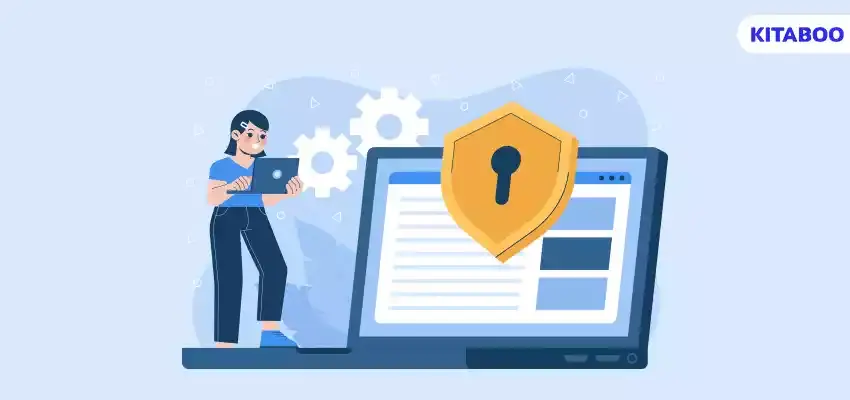
eBook Protection Perfected: The Ultimate ePub DRM
Summarize this blog with your favorite AI:
The interconnectivity of the internet age acts as both a boon and a curse, making the illegal sharing of content more prevalent than ever before. As the popularity of eBooks continues to rise, authors feel an increasing need to protect their intellectual property through robust Digital Rights Management (DRM) solutions.
ePub DRM offers publishers and authors a secure means to safeguard digital content created and distributed in the highly versatile and adaptive ePub format from piracy and unauthorized distribution.
In this blog, we will explore the evolution of eBook DRM technology and how it safeguards digital content.
Table of Contents
V. Resolving Emerging Challenges
VI. Conclusion
The Evolution of eBook DRM
In the early days of digital publishing, DRM solutions were typically ineffective at preventing piracy. However, with an increasing demand for secure eBook distribution, DRM technologies have seen significant advancements.
eBook DRM solutions relying on simple encryption techniques are vulnerable to hacking and circumvention. As a result, DRM providers began to develop sophisticated encryption algorithms and security measures to counteract this.
Over time, DRM solutions evolved into more complex mechanisms, such as license management systems, that allowed publishers to have greater control over how their eBooks were distributed. The integration of DRM technologies with eBook distribution platforms streamlines the process of protecting content.
ePub DRM offers publishers and authors a solution for protecting their intellectual property through encryption algorithms and license management for extensive security in digital publishing.
Understanding ePub DRM
ePub DRM involves encrypting the content of an ePub file to prevent unauthorized access and distribution. This ensures that only users with the appropriate decryption key can access the eBook.
The encryption process involves encoding the eBook file in such a way that it becomes unreadable without the decryption key. This key is typically provided to authorized users upon purchase of the eBook.
ePub DRM often also includes features like license management, which allows publishers to control how and where their eBooks are accessed. This can involve limiting the number of devices on which the eBook can be accessed or setting expiration dates for access.
Some solutions even use watermarking to trace the source of unauthorized copies and take action against piracy.
Key Features of ePub DRM
Digital textbook platforms such as KITABOO allow authors and publishers to protect their literary works through several DRM mechanisms including:
Encryption
As mentioned above, encryption implies making the content unreadable for humans, without the decryption key. This is done using advanced encryption algorithms. By encrypting the content, it ensures that only authorized users can read the eBook.
License Management
As the name suggests, this enables publishers to manage licenses effectively and control how their eBooks are accessed. This can include limiting the number of devices a user can access the eBook on and setting access expiration dates.
Watermarking
Some DRM solutions incorporate watermarking, which embeds unique identifiers into each eBook copy. This allows publishers to trace the source of unauthorized copies.
Integration with Distribution Platforms
Many digital publishing platforms, such as KITABOO, offer built-in support for ePub DRM, which makes it easy for publishers to protect their content. This integration streamlines the DRM process and ensures extensive security for eBooks.
Benefits of ePub DRM
The implementation of ePub DRM provides the following benefits for authors and publishers:
1. Protection Against Piracy
DRM encrypts eBook files and implements strict access controls, deterring piracy and unauthorized distribution. This helps publishers and authors safeguard their intellectual property.
2. Increased Revenue
With DRM, publishers can distribute their ePub eBooks across various channels without fear of content piracy. This allows them to focus on marketing and promoting their eBooks to increase sales and revenue.
3. Enhanced Reader Experiences
While DRM may be seen as a barrier to entry by some users, it contributes to a safer and more secure reading experience. In ePub eBooks it ensures that readers can access high-quality content without encountering unauthorized copies or malware-infected files.
4. Legal Compliance
DRM mechanisms help publishers and authors maintain compliance with copyright laws and regulations. By implementing DRM technology, they demonstrate a commitment to protecting their intellectual property and respecting the rights of content creators.
Resolving Emerging Challenges
One of the primary concerns surrounding the implementation of DRM is its potential impact on the user experience. Some users may find DRM restrictions intrusive.
To resolve this challenge, publishers and DRM providers can focus on implementing user-friendly DRM solutions that don’t hinder the reading experience. This can involve establishing flexible licensing options, allowing users to access their eBooks on multiple devices, or providing temporary access to DRM-protected content for preview.
As with any technology, DRM methods can be circumvented by determined individuals with the right technical expertise. To mitigate this risk, publishers can employ multi-layered DRM strategies that incorporate various security measures, such as encryption and device authentication. Publishers can make it more difficult to bypass DRM protections and distribute unauthorized copies.
Publishers can provide clear explanations of why DRM is necessary to protect intellectual property rights and emphasize the negative impact that piracy can have on the publishing industry. By raising awareness about copyright laws, publishers can garner support for DRM initiatives and encourage users to purchase legitimate copies of eBooks.
By addressing user concerns and promoting awareness about piracy issues, publishers can maximize the effectiveness of ePub DRM and safeguard their intellectual property against unauthorized distribution.
Conclusion
These DRM mechanisms offer publishers and authors a comprehensive solution to safeguard their intellectual ePub eBooks. The advanced encryption algorithms and license management, provides some respite against piracy and unauthorized distribution. As the eBook market continues to expand its user base, this helps ensure the integrity and security of digital assets.
Digital textbook platforms such as KITABOO allow authors and publishers to implement extensive DRM protections for their literary works, allowing them to securely distribute their content without having to worry about revenue and exposure losses derived from the unauthorized distribution of their content.
Connect with us to learn more about ePub DRM protection.
Discover how a mobile-first training platform can help your organization.
KITABOO is a cloud-based platform to create, deliver & track mobile-first interactive training content.


![Top 5 Free Publishing Sites for Independent Publishing [2026]](https://kitaboo.com/wp-content/uploads/2025/09/Top-5-Free-Publishing-Sites-for-Independent-Publishing-2026-420x235.webp)
